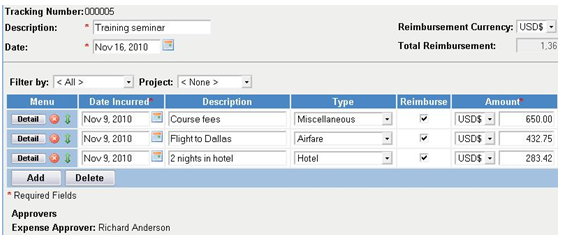Timesheet Feature Review #2: Expense Reporting
If you have been visiting our blog regularly, you may have noticed that Software Shortlist recently published a list of 13 “must have” features for prospective timesheet buyers. Today, I’ll take a detailed look into the #2 most highly requested timesheet feature – expense reporting.
Any project worth its salt is bound to rack up expenses along the way, be it a training seminar for your workers or a software purchase for product development, almost every project will have its own miscellaneous costs to be recorded. However, how do you track these external expenses yet keep them separate from your actual billable time? Well, the answer lies in expense reporting features.
Exactly How Do Expense Reports Help Users?
Expense reports allow users to record miscellaneous expenses as separate from billable time. When creating your timesheets, expense reporting allows you to create a separate report just for the expenses incurred by the project/task. This streamlines the whole process and makes managing projects easier for project administrators and accountants. Both your timesheets and expense reports can be submitted together, making for regular and more accurate expense reports.
Timesheets are all about organization and accuracy. In order to maintain the perfect timesheet system, workers need to be able to enter reports that are easy to read and track. Expense reports allow workers to compartmentalize their costs and bills and in the process, create clear and concise reports for approval. Regular expense reporting also makes for more accurate billing as workers do not have to work back from memory to ensure that all expenses are accounted for at the end of the project.
Manage Both Time And Expenses
Expense reports are also often submitted together with timesheets so that costs and bills can be processed at the same time. This ensures that project teams can apply for expense reimbursements and bill their clients all at the same time. Project managers also have a much easier time reviewing and approving the reports generated as they are able to easily check where the project funds are being used and see if the expenses incurred are reasonable.
Regular expense reports can also help projects receive reimbursement for their costs faster; this will definitely be invaluable to cash-strapped projects and ensures that projects can remain well-funded.
There aren’t really any good working alternatives for expense reporting; the only other ways to submit costs incurred would be to include them in the timesheet as billable time or to simply compile the expenses at the end of the project. As you might imagine, billing expenses as part of the timesheet is far from ideal as it becomes very difficult to distinguish between actual works done and “filler time” meant to cover expense costs. As for compiling expenses at the end of the project, this has its own complications and drawbacks as well, including accuracy concerns and accounts reliability.
What are the Drawbacks to Expense Reporting?
Ironically, the greatest strength of expense reports also turns out to be their biggest weakness. By submitting separate reports for billed time and expenses, it is a sure-fire way of creating numerous documents that may be difficult to keep track off. The fact that expense reports are submitted together with timesheets helps alleviate this problem but a good administrative system is a must in order for expense reports to reach their maximum potential.
Depending on the different personalities of your workers, expense reports can also turn into a cumbersome chore for your project teams. In most projects, expenses are compiled and filed at the end of the project, once all the work has been completed. Some workers may thus find creating expense reports on a regular basis to be unnecessary and troublesome. If there happens to be a system already in place to keep track of expense receipts, regular expense reporting becomes even more unnecessary.
In Conclusion
The ability to include expense reports together with timesheets is the second most requested feature by the users of Software Shortlist’s comparison service. You might thus be surprised to know that only 14 out of the 21 timesheet software reviewed by our software panel allow users to include expense reports together with their timesheets. Hopefully, this article has provided you with a better understanding of how expense reports work, why they are considered “must haves” amongst most users and also the possible drawbacks of adopting them.
Have Your Say
Now that you have a better idea of how expense reports work, why not tell us what you think of regular expense reporting? We’d love to hear from you regarding your preferred method to reporting expenses and why.
Stay tuned for more upcoming articles of the other top “must have” timesheet software features. Next time, we will be looking at the ability to distinguish between billable and non-billable work…

